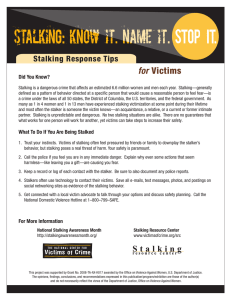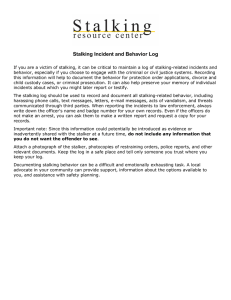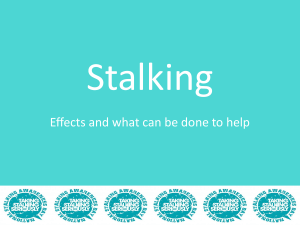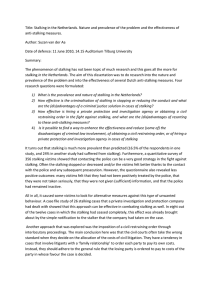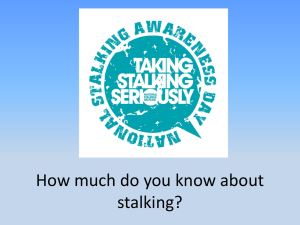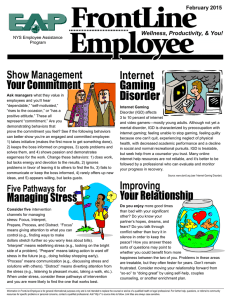stalking f a c t s h e e... S t a l k i n g
advertisement
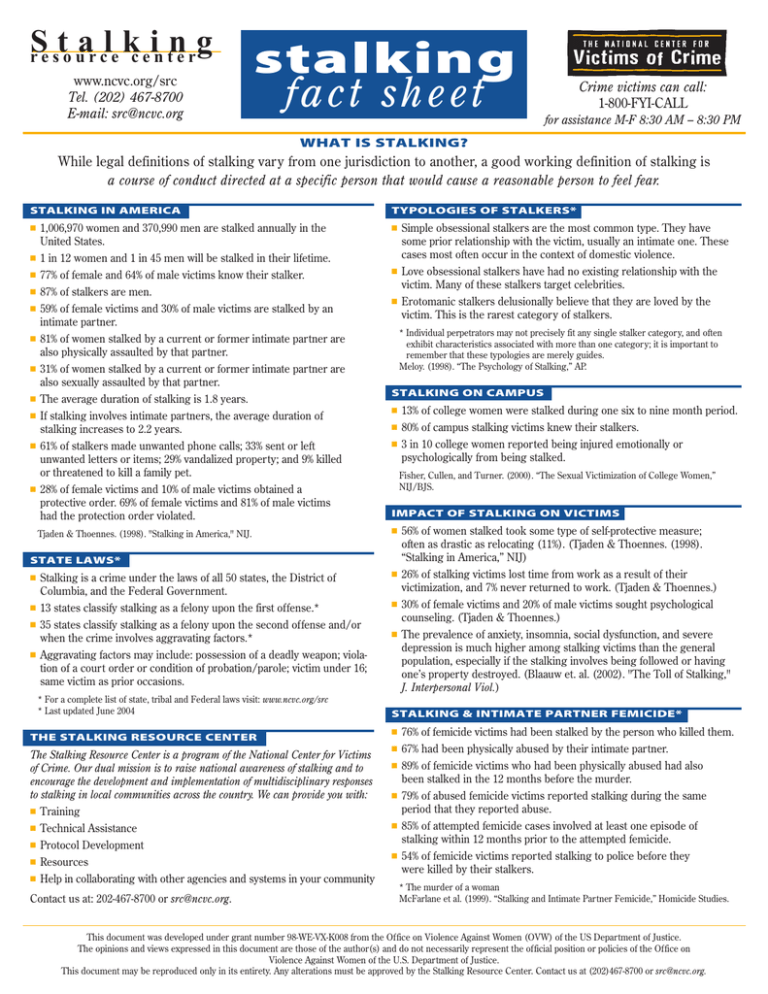
S talking resource center www.ncvc.org/src Tel. (202) 467-8700 E-mail: src@ncvc.org stalking fact sheet Crime victims can call: 1-800-FYI-CALL for assistance M-F 8:30 AM – 8:30 PM WHAT IS STALKING? While legal definitions of stalking vary from one jurisdiction to another, a good working definition of stalking is a course of conduct directed at a specific person that would cause a reasonable person to feel fear. STALKING IN AMERICA ■ ■ ■ ■ ■ ■ ■ ■ ■ ■ ■ 1,006,970 women and 370,990 men are stalked annually in the United States. 1 in 12 women and 1 in 45 men will be stalked in their lifetime. 77% of female and 64% of male victims know their stalker. 87% of stalkers are men. 59% of female victims and 30% of male victims are stalked by an intimate partner. 81% of women stalked by a current or former intimate partner are also physically assaulted by that partner. 31% of women stalked by a current or former intimate partner are also sexually assaulted by that partner. The average duration of stalking is 1.8 years. If stalking involves intimate partners, the average duration of stalking increases to 2.2 years. 61% of stalkers made unwanted phone calls; 33% sent or left unwanted letters or items; 29% vandalized property; and 9% killed or threatened to kill a family pet. 28% of female victims and 10% of male victims obtained a protective order. 69% of female victims and 81% of male victims had the protection order violated. Tjaden & Thoennes. (1998). "Stalking in America," NIJ. TYPOLOGIES OF STALKERS* ■ ■ ■ * Individual perpetrators may not precisely fit any single stalker category, and often exhibit characteristics associated with more than one category; it is important to remember that these typologies are merely guides. Meloy. (1998). “The Psychology of Stalking,” AP. STALKING ON CAMPUS ■ ■ ■ ■ ■ ■ Stalking is a crime under the laws of all 50 states, the District of Columbia, and the Federal Government. 13 states classify stalking as a felony upon the first offense.* 35 states classify stalking as a felony upon the second offense and/or when the crime involves aggravating factors.* Aggravating factors may include: possession of a deadly weapon; violation of a court order or condition of probation/parole; victim under 16; same victim as prior occasions. * For a complete list of state, tribal and Federal laws visit: www.ncvc.org/src * Last updated June 2004 THE STALKING RESOURCE CENTER The Stalking Resource Center is a program of the National Center for Victims of Crime. Our dual mission is to raise national awareness of stalking and to encourage the development and implementation of multidisciplinary responses to stalking in local communities across the country. We can provide you with: ■ Training ■ Technical Assistance ■ Protocol Development ■ Resources ■ Help in collaborating with other agencies and systems in your community Contact us at: 202-467-8700 or src@ncvc.org. 13% of college women were stalked during one six to nine month period. 80% of campus stalking victims knew their stalkers. 3 in 10 college women reported being injured emotionally or psychologically from being stalked. Fisher, Cullen, and Turner. (2000). “The Sexual Victimization of College Women,” NIJ/BJS. IMPACT OF STALKING ON VICTIMS ■ STATE LAWS* ■ Simple obsessional stalkers are the most common type. They have some prior relationship with the victim, usually an intimate one. These cases most often occur in the context of domestic violence. Love obsessional stalkers have had no existing relationship with the victim. Many of these stalkers target celebrities. Erotomanic stalkers delusionally believe that they are loved by the victim. This is the rarest category of stalkers. ■ ■ ■ 56% of women stalked took some type of self-protective measure; often as drastic as relocating (11%). (Tjaden & Thoennes. (1998). “Stalking in America,” NIJ) 26% of stalking victims lost time from work as a result of their victimization, and 7% never returned to work. (Tjaden & Thoennes.) 30% of female victims and 20% of male victims sought psychological counseling. (Tjaden & Thoennes.) The prevalence of anxiety, insomnia, social dysfunction, and severe depression is much higher among stalking victims than the general population, especially if the stalking involves being followed or having one’s property destroyed. (Blaauw et. al. (2002). "The Toll of Stalking," J. Interpersonal Viol.) STALKING & INTIMATE PARTNER FEMICIDE* ■ ■ ■ ■ ■ ■ 76% of femicide victims had been stalked by the person who killed them. 67% had been physically abused by their intimate partner. 89% of femicide victims who had been physically abused had also been stalked in the 12 months before the murder. 79% of abused femicide victims reported stalking during the same period that they reported abuse. 85% of attempted femicide cases involved at least one episode of stalking within 12 months prior to the attempted femicide. 54% of femicide victims reported stalking to police before they were killed by their stalkers. * The murder of a woman McFarlane et al. (1999). “Stalking and Intimate Partner Femicide,” Homicide Studies. This document was developed under grant number 98-WE-VX-K008 from the Office on Violence Against Women (OVW) of the US Department of Justice. The opinions and views expressed in this document are those of the author(s) and do not necessarily represent the official position or policies of the Office on Violence Against Women of the U.S. Department of Justice. This document may be reproduced only in its entirety. Any alterations must be approved by the Stalking Resource Center. Contact us at (202)467-8700 or src@ncvc.org.
